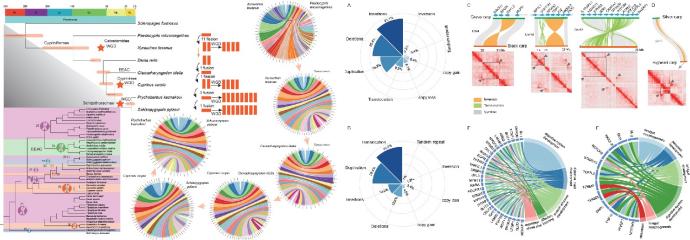
Newsroom
Genomics Features for Adaptation and Evolutionary Dynamics of Four Major Asian Domestic Carps
During the evolutionary process, species gradually develop a variety of evolutionary forms in response to changes in ecological niches and survival needs over the course of long-term evolution. Divergent evolution refers to the process in which organisms, originating from a common ancestor, adapt to different environments and occupy distinct ecological niches, leading to the development in two or more directions during the course of evolution.
Ctenopharyngodon idella (grass carp), Mylopharyngodon piceus (black carp), Aristichthys nobilis (bighead carp), and Hypophthalmichthys molitrix (silver carp) are known in China as the “Four Major Asian Domestic Carps” [Cypriniformes: Cyprinidae]. They represent the primary freshwater aquaculture fishes in China and hold an important position in the global aquaculture industry. They are not only noted for their unique behaviors in migration and the production of pelagic eggs but also for their diverse habitat preferences, which allow them to efficiently utilize food resources from different water strata, thus achieving ecological harmony. Furthermore, their rapid growth rates and large sizes make these four species crucial to both China's and the world's aquaculture sectors.
Recently, a research group led by Prof. HE Shunping from the Institute of Hydrobiology (IHB) of the Chinese Academy of Sciences illustrated the dynamic evolutionary process of the chromosomes in the Cypriniformes, along with the genetic mechanisms behind dietary differentiation and niche adaptability evolution in the four major domestic carps. This study was published in Science China Life Sciences.
This study utilized advanced sequencing technologies to successfully assemble the highest-quality chromosomal-level genomes of the Four Major Domestic Fishes to date. Through detailed comparisons of these genomes, the research revealed their evolutionary history, showing that the Four Major Domestic Fishes exhibit similar genomic characteristics and evolutionary rates, and originated from the same ancestral species. Furthermore, the study delved into the dynamic evolutionary process of chromosomes in the Cypriniformes. It was found that within the Cypriniformes, species' chromosomes have undergone frequent fission and fusion events, as well as phenomena of chromosome number doubling. These complex chromosomal evolutionary processes collectively contribute to the unique species diversity and extensive adaptability of the Cypriniformes.
Further research has found that variations in genome structure and related functional genes play a crucial role in the differential differentiation among the Four Major Domestic Fishes. The study identified a series of structural variations affecting key functional genes in these fish species. These functional genes are closely related to various aspects of the fishes' biology, including growth and development, dietary preferences, digestive system functionality, and behavioral responses. Moreover, the research also discovered positively selected genes and expanded gene families associated with the growth and energy supply of the Four Major Domestic Fishes.
“These findings not only elucidate the genetic basis of ecological adaptation and dietary selection in the Four Major Domestic Fishes but also offer new perspectives on understanding the biodiversity and evolutionary mechanisms of the Cypriniformes fish. They lay a foundation for future in-depth studies on ecological and evolutionary differences among closely related species.” said Prof. He.
Through these research findings, we can better understand how variations at the genomic level affect the biological characteristics of fish. This knowledge is of significant importance for the improvement of aquaculture, species conservation, and the maintenance of biodiversity, providing valuable genetic information and theoretical support for future research and applications.

The dynamic evolution of chromosomes in the Cypriniformes, as well as structural variations influencing important functional genes of four major Asian domestic carps(Image by IHB)
(Editor. WANG Hongxia)